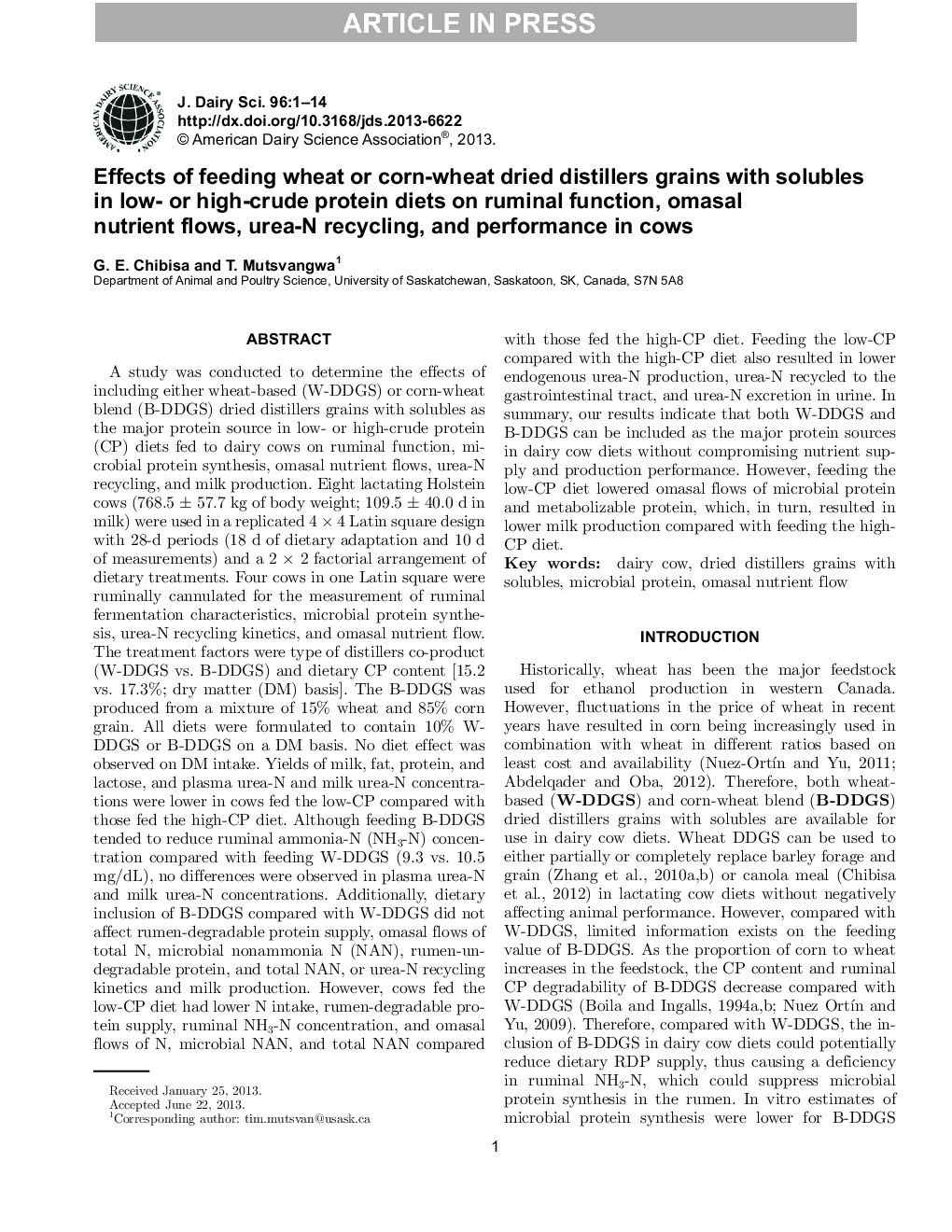| کد مقاله | کد نشریه | سال انتشار | مقاله انگلیسی | نسخه تمام متن |
|---|---|---|---|---|
| 10975941 | 1108037 | 2013 | 14 صفحه PDF | دانلود رایگان |
عنوان انگلیسی مقاله ISI
Effects of feeding wheat or corn-wheat dried distillers grains with solubles in low- or high-crude protein diets on ruminal function, omasal nutrient flows, urea-N recycling, and performance in cows
دانلود مقاله + سفارش ترجمه
دانلود مقاله ISI انگلیسی
رایگان برای ایرانیان
کلمات کلیدی
موضوعات مرتبط
علوم زیستی و بیوفناوری
علوم کشاورزی و بیولوژیک
علوم دامی و جانورشناسی
پیش نمایش صفحه اول مقاله

چکیده انگلیسی
A study was conducted to determine the effects of including either wheat-based (W-DDGS) or corn-wheat blend (B-DDGS) dried distillers grains with solubles as the major protein source in low- or high-crude protein (CP) diets fed to dairy cows on ruminal function, microbial protein synthesis, omasal nutrient flows, urea-N recycling, and milk production. Eight lactating Holstein cows (768.5 ± 57.7 kg of body weight; 109.5 ± 40.0 d in milk) were used in a replicated 4 Ã 4 Latin square design with 28-d periods (18 d of dietary adaptation and 10 d of measurements) and a 2 Ã 2 factorial arrangement of dietary treatments. Four cows in one Latin square were ruminally cannulated for the measurement of ruminal fermentation characteristics, microbial protein synthesis, urea-N recycling kinetics, and omasal nutrient flow. The treatment factors were type of distillers co-product (W-DDGS vs. B-DDGS) and dietary CP content [15.2 vs. 17.3%; dry matter (DM) basis]. The B-DDGS was produced from a mixture of 15% wheat and 85% corn grain. All diets were formulated to contain 10% W-DDGS or B-DDGS on a DM basis. No diet effect was observed on DM intake. Yields of milk, fat, protein, and lactose, and plasma urea-N and milk urea-N concentrations were lower in cows fed the low-CP compared with those fed the high-CP diet. Although feeding B-DDGS tended to reduce ruminal ammonia-N (NH3-N) concentration compared with feeding W-DDGS (9.3 vs. 10.5 mg/dL), no differences were observed in plasma urea-N and milk urea-N concentrations. Additionally, dietary inclusion of B-DDGS compared with W-DDGS did not affect rumen-degradable protein supply, omasal flows of total N, microbial nonammonia N (NAN), rumen-undegradable protein, and total NAN, or urea-N recycling kinetics and milk production. However, cows fed the low-CP diet had lower N intake, rumen-degradable protein supply, ruminal NH3-N concentration, and omasal flows of N, microbial NAN, and total NAN compared with those fed the high-CP diet. Feeding the low-CP compared with the high-CP diet also resulted in lower endogenous urea-N production, urea-N recycled to the gastrointestinal tract, and urea-N excretion in urine. In summary, our results indicate that both W-DDGS and B-DDGS can be included as the major protein sources in dairy cow diets without compromising nutrient supply and production performance. However, feeding the low-CP diet lowered omasal flows of microbial protein and metabolizable protein, which, in turn, resulted in lower milk production compared with feeding the high-CP diet.
ناشر
Database: Elsevier - ScienceDirect (ساینس دایرکت)
Journal: Journal of Dairy Science - Volume 96, Issue 10, October 2013, Pages 6550-6563
Journal: Journal of Dairy Science - Volume 96, Issue 10, October 2013, Pages 6550-6563
نویسندگان
G.E. Chibisa, T. Mutsvangwa,